法律英语教程
- 格式:ppt
- 大小:134.00 KB
- 文档页数:12
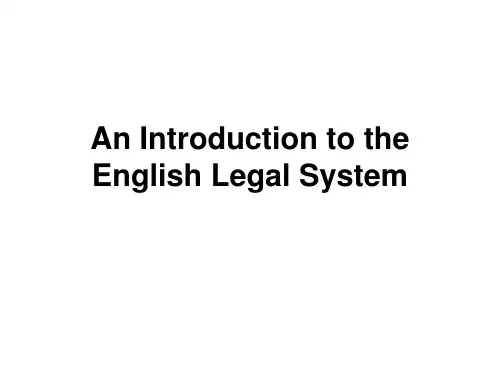
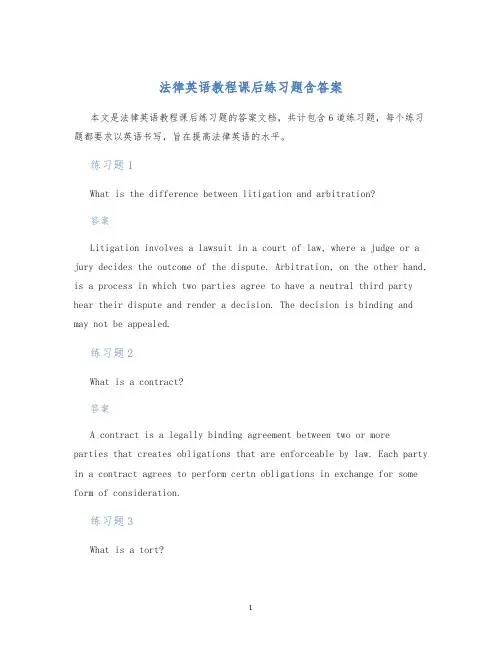
法律英语教程课后练习题含答案本文是法律英语教程课后练习题的答案文档,共计包含6道练习题,每个练习题都要求以英语书写,旨在提高法律英语的水平。
练习题1What is the difference between litigation and arbitration?答案Litigation involves a lawsuit in a court of law, where a judge or a jury decides the outcome of the dispute. Arbitration, on the other hand, is a process in which two parties agree to have a neutral third party hear their dispute and render a decision. The decision is binding and may not be appealed.练习题2What is a contract?答案A contract is a legally binding agreement between two or moreparties that creates obligations that are enforceable by law. Each party in a contract agrees to perform certn obligations in exchange for some form of consideration.练习题3What is a tort?A tort is a civil wrong that causes harm or injury to another person or property. Examples of torts include negligence, defamation, invasion of privacy, and intentional infliction of emotional distress.练习题4What is intellectual property?答案Intellectual property refers to creations of the mind, such as inventions, literary and artistic works, designs, symbols, and names used in commerce. The law protects intellectual property through patents, trademarks, and copyrights.练习题5What is a trademark?答案A trademark is a symbol, word, phrase, or design that identifies and distinguishes the goods or services of one party from those of another. Trademarks are protected by law and can be registered with the government.练习题6What is the difference between a felony and a misdemeanor?A felony is a serious crime that is punishable by imprisonment in a state or federal prison for more than a year. Examples of felonies include murder, robbery, and drug trafficking. A misdemeanor, on the other hand, is a less serious crime that is punishable by a fine or imprisonment in a local jl for up to a year. Examples of misdemeanors include traffic violations, disorderly conduct, and petty theft.以上是本文的6道法律英语练习题及答案,希望对您的法律英语学习有所帮助。
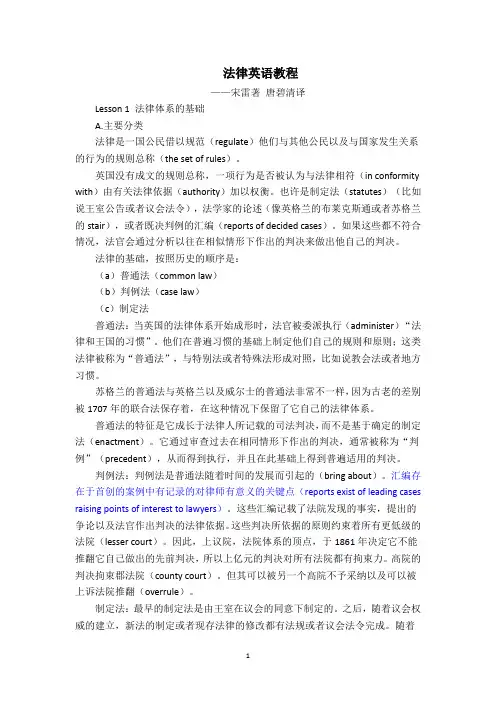
法律英语教程——宋雷著唐碧清译Lesson 1 法律体系的基础A.主要分类法律是一国公民借以规范(regulate)他们与其他公民以及与国家发生关系的行为的规则总称(the set of rules)。
英国没有成文的规则总称,一项行为是否被认为与法律相符(in conformity with)由有关法律依据(authority)加以权衡。
也许是制定法(statutes)(比如说王室公告或者议会法令),法学家的论述(像英格兰的布莱克斯通或者苏格兰的stair),或者既决判例的汇编(reports of decided cases)。
如果这些都不符合情况,法官会通过分析以往在相似情形下作出的判决来做出他自己的判决。
法律的基础,按照历史的顺序是:(a)普通法(common law)(b)判例法(case law)(c)制定法普通法:当英国的法律体系开始成形时,法官被委派执行(administer)“法律和王国的习惯”。
他们在普遍习惯的基础上制定他们自己的规则和原则;这类法律被称为“普通法”,与特别法或者特殊法形成对照,比如说教会法或者地方习惯。
苏格兰的普通法与英格兰以及威尔士的普通法非常不一样,因为古老的差别被1707年的联合法保存着,在这种情况下保留了它自己的法律体系。
普通法的特征是它成长于法律人所记载的司法判决,而不是基于确定的制定法(enactment)。
它通过审查过去在相同情形下作出的判决,通常被称为“判例”(precedent),从而得到执行,并且在此基础上得到普遍适用的判决。
判例法:判例法是普通法随着时间的发展而引起的(bring about)。
汇编存在于首创的案例中有记录的对律师有意义的关键点(reports exist of leading cases raising points of interest to lawyers)。
这些汇编记载了法院发现的事实,提出的争论以及法官作出判决的法律依据。
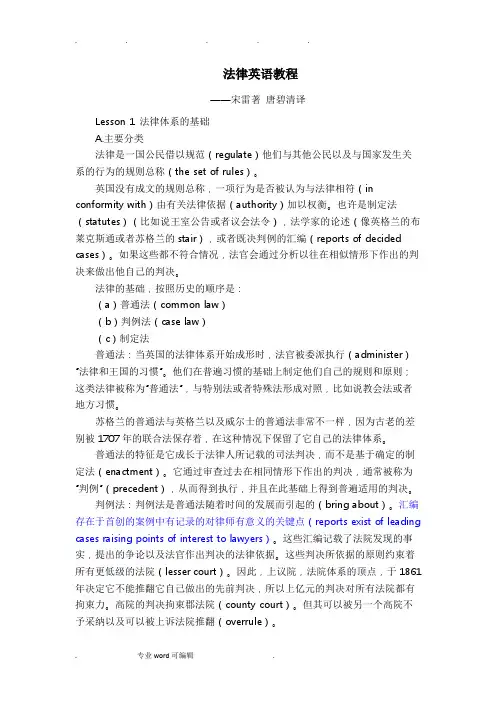
法律英语教程——宋雷著唐碧清译Lesson 1 法律体系的基础A.主要分类法律是一国公民借以规范(regulate)他们与其他公民以及与国家发生关系的行为的规则总称(the set of rules)。
英国没有成文的规则总称,一项行为是否被认为与法律相符(in conformity with)由有关法律依据(authority)加以权衡。
也许是制定法(statutes)(比如说王室公告或者议会法令),法学家的论述(像英格兰的布莱克斯通或者苏格兰的stair),或者既决判例的汇编(reports of decided cases)。
如果这些都不符合情况,法官会通过分析以往在相似情形下作出的判决来做出他自己的判决。
法律的基础,按照历史的顺序是:(a)普通法(common law)(b)判例法(case law)(c)制定法普通法:当英国的法律体系开始成形时,法官被委派执行(administer)“法律和王国的习惯”。
他们在普遍习惯的基础上制定他们自己的规则和原则;这类法律被称为“普通法”,与特别法或者特殊法形成对照,比如说教会法或者地方习惯。
苏格兰的普通法与英格兰以及威尔士的普通法非常不一样,因为古老的差别被1707年的联合法保存着,在这种情况下保留了它自己的法律体系。
普通法的特征是它成长于法律人所记载的司法判决,而不是基于确定的制定法(enactment)。
它通过审查过去在相同情形下作出的判决,通常被称为“判例”(precedent),从而得到执行,并且在此基础上得到普遍适用的判决。
判例法:判例法是普通法随着时间的发展而引起的(bring about)。
汇编存在于首创的案例中有记录的对律师有意义的关键点(reports exist of leading cases raising points of interest to lawyers)。
这些汇编记载了法院发现的事实,提出的争论以及法官作出判决的法律依据。
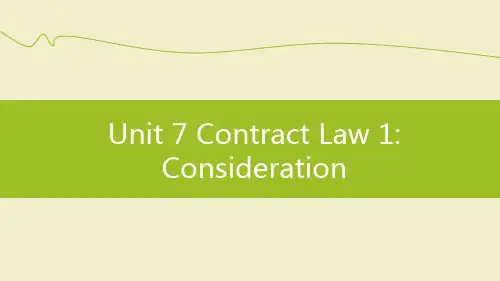
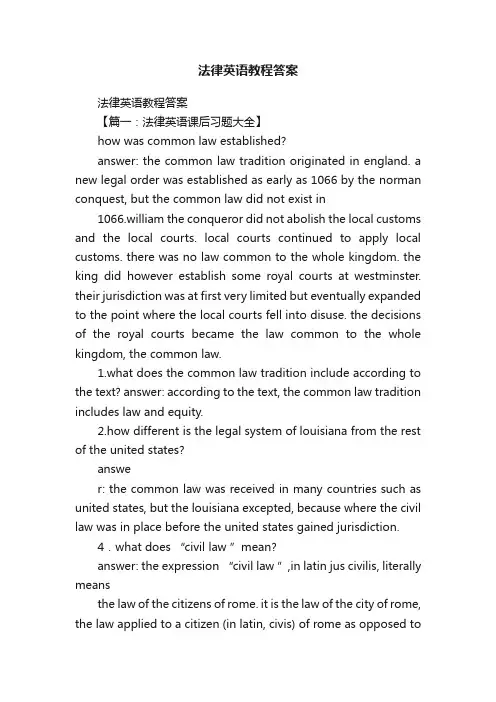
法律英语教程答案法律英语教程答案【篇一:法律英语课后习题大全】how was common law established?answer: the common law tradition originated in england. a new legal order was established as early as 1066 by the norman conquest, but the common law did not exist in1066.william the conqueror did not abolish the local customs and the local courts. local courts continued to apply local customs. there was no law common to the whole kingdom. the king did however establish some royal courts at westminster. their jurisdiction was at first very limited but eventually expanded to the point where the local courts fell into disuse. the decisions of the royal courts became the law common to the whole kingdom, the common law.1.what does the common law tradition include according to the text? answer: according to the text, the common law tradition includes law and equity.2.how different is the legal system of louisiana from the rest of the united states?answer: the common law was received in many countries such as united states, but the louisiana excepted, because where the civil law was in place before the united states gained jurisdiction.4.what does “civil law ”mean?answer: the expression “civil law ”,in latin jus civilis, literally meansthe law of the citizens of rome. it is the law of the city of rome, the law applied to a citizen (in latin, civis) of rome as opposed tothe law applied to a non-citizen.5.what is the main difference between the civil law system and common law system?answer: first and foremost, cases are usually considered to be the primary source of law in common law countries, but in civil law countries, cases are simply not a source of law---at least in theory. civil law jurist will consider the civil code as an all encompassing document, but in common law jurisdictions legislation tends to be considered as an exception to the case law.6.what different attitudes do the civil law system and the common law system hold towards case law?answer: cases are usually considered to be the primary source of law in common law countries, but in civil law countries, cases are simply not a source of law---at least in theory, but cases are becoming more and more relevant in civil law countries, but the attitudes of civilians and common lawyers toward legislation and cases differ greatly.7.what is significant about the american legal education? how is law school teaching different from ours?answer: american legal education is very original and in many respects unique. legal education tends to be longer than other common lawcountries; law is a postgraduate degree in the u.s.the teaching style is magisterial----the professor exposes the law to his or her students, who take notes and do not intervene in class.8. is law degree an undergraduate degree in the u.s.? how do people get a law degree in the u.s.?answer: no, the law degree is a master degree in the u.s., thestudents must have at least a bachelors degree in some area of study, and then to study the law and get the law degree.9. can you compare the legal method employed in the american legal education and the legal method used in other countries?answer: american legal education is a very original and in many respects unique. the case method or socratic method is peculiar to this country .it must be clear to you by now that the case method could not have been thought of in a civil law country. in those countries (as in the case in england) law is an undergraduate degree. legal education tends to be longer than in the united states. the teaching style is magisterial-the professor exposes the law to his or her students, who take notes and do not intervene in class.10. who play an important role in defining the law in civil law system, law professors or judges? what about the common law system?answer: law professors, because civil law students will read law doctrine more than cases. the doctrine is the cumulated writings oflaw professors on what the law is or should be. in civil law the doctrine is considered to be a source of law and a highly respected one. you have to remember that the university, not the courts, reintroduced the civil law in continental europe. it is therefore not surprising that law professors still have an import role in defining the law. common law professors generally do not enjoy a similar prestige within their own jurisdiction. here the judges get most of the prestige. 1. how is case law created?the decisions of judges, or of other officials empowered by the constitution or laws of a political entity to hear and decidecontroversies, create case law.2. what dose a particular decision mean to the parties to a lawsuit?to the lawyers, judges, and law students?1) from the point of view of parties to a lawsuit or other contestedcontroversy, what matters is the immediate outcome, the result the tribunal reaches in their case. it means wether the aggrieved party or damaged party will obtain a remedy.2) in the view of judges, lawyers and law students, however, the decisiontakes on broader perspective. the decision becomes a possible source of general applicable case law.3. according to professor llwellyn, what creates a legal system ofprecedent? why and when?1) those generalizations contained in, or built upon, past decisionscreate a legal system of precedent.2) because as rules of action arise out of the solution of particularproblems, in any judicial system rules of law arise sooner or later out of such decisions of cases, weather or not such formulations are desired, intended or consciously recognized.3) when those generalizations are taken as normative for future dispute,a legal system of precedent created.4. what might happen if a court follows the precedentsmechanically?a court that follows precedent mechanically or too strictlywill at times perpetuate legal rules and concepts5. what is the problem remaining in the legal system recognizing past decisions as authoritative sources of law for future cases?the continuing problem in a legal system that recognizes past decisions as authoritative sources of law for future cases is how to maintain an acceptable accommodation of the competing values of stability in a law, served by adherence to precedent, and responsiveness to social change, which may call for the abandonment of an outworn legal doctrine.6. explain these two latin terms: “stare decisis” and “res judicata”?【篇二:法律英语教程第2单元text a翻译】高法院以“一种强烈地分裂的争议”的方式谈及了堕胎案,这种争议“有寻常案件的判决所不具有的维度”。
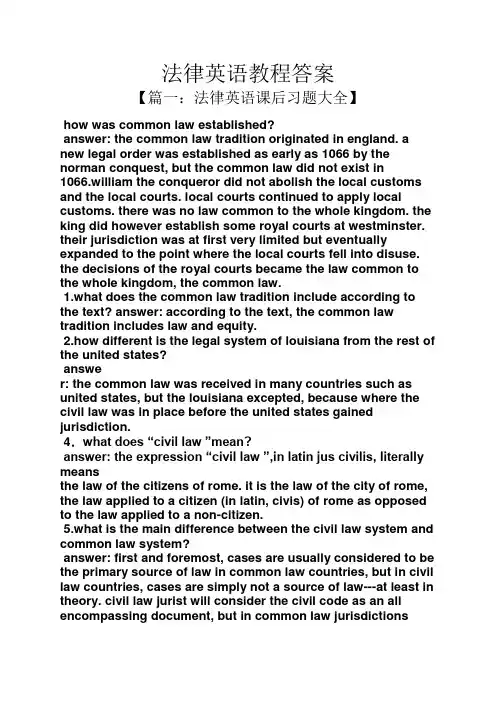
法律英语教程答案【篇一:法律英语课后习题大全】how was common law established?answer: the common law tradition originated in england. a new legal order was established as early as 1066 by the norman conquest, but the common law did not exist in1066.william the conqueror did not abolish the local customs and the local courts. local courts continued to apply local customs. there was no law common to the whole kingdom. the king did however establish some royal courts at westminster. their jurisdiction was at first very limited but eventually expanded to the point where the local courts fell into disuse. the decisions of the royal courts became the law common to the whole kingdom, the common law.1.what does the common law tradition include according to the text? answer: according to the text, the common law tradition includes law and equity.2.how different is the legal system of louisiana from the rest of the united states?answer: the common law was received in many countries such as united states, but the louisiana excepted, because where the civil law was in place before the united states gained jurisdiction.4.what does “civil law ”mean?answer: the expression “civil law ”,in latin jus civilis, literally meansthe law of the citizens of rome. it is the law of the city of rome, the law applied to a citizen (in latin, civis) of rome as opposed to the law applied to a non-citizen.5.what is the main difference between the civil law system and common law system?answer: first and foremost, cases are usually considered to be the primary source of law in common law countries, but in civil law countries, cases are simply not a source of law---at least in theory. civil law jurist will consider the civil code as an all encompassing document, but in common law jurisdictionslegislation tends to be considered as an exception to the case law.6.what different attitudes do the civil law system and the common law system hold towards case law?answer: cases are usually considered to be the primary source of law in common law countries, but in civil law countries, cases are simply not a source of law---at least in theory, but cases are becoming more and more relevant in civil law countries, but the attitudes of civilians and common lawyers toward legislation and cases differ greatly.7.what is significant about the american legal education? how is law school teaching different from ours?answer: american legal education is very original and in many respects unique. legal education tends to be longer than other common lawcountries; law is a postgraduate degree in the u.s.the teaching style is magisterial----the professor exposes the law to his or her students, who take notes and do not intervene in class.8. is law degree an undergraduate degree in the u.s.? how do people get a law degree in the u.s.?answer: no, the law degree is a master degree in the u.s., the students must have at least a bachelors degree in some areaof study, and then to study the law and get the law degree.9. can you compare the legal method employed in the american legal education and the legal method used in other countries?answer: american legal education is a very original and in many respects unique. the case method or socratic method is peculiar to this country .it must be clear to you by now that the case method could not have been thought of in a civil law country. in those countries (as in the case in england) law is an undergraduate degree. legal education tends to be longer than in the united states. the teaching style is magisterial-the professor exposes the law to his or her students, who take notes and do not intervene in class.10. who play an important role in defining the law in civil law system, law professors or judges? what about the common law system?answer: law professors, because civil law students will read law doctrine more than cases. the doctrine is the cumulated writings oflaw professors on what the law is or should be. in civil law the doctrine is considered to be a source of law and a highly respected one. you have to remember that the university, not the courts, reintroduced the civil law in continental europe. it is therefore not surprising that law professors still have an import role in defining the law. common law professors generally do not enjoy a similar prestige within their own jurisdiction. here the judges get most of the prestige. 1. how is case law created?the decisions of judges, or of other officials empowered by the constitution or laws of a political entity to hear and decide controversies, create case law.2. what dose a particular decision mean to the parties to a lawsuit?to the lawyers, judges, and law students?1) from the point of view of parties to a lawsuit or other contestedcontroversy, what matters is the immediate outcome, the result the tribunal reaches in their case. it means wether the aggrieved party or damaged party will obtain a remedy.2) in the view of judges, lawyers and law students, however, the decisiontakes on broader perspective. the decision becomes a possible source of general applicable case law.3. according to professor llwellyn, what creates a legal system ofprecedent? why and when?1) those generalizations contained in, or built upon, past decisionscreate a legal system of precedent.2) because as rules of action arise out of the solution of particularproblems, in any judicial system rules of law arise sooner or later out of such decisions of cases, weather or not such formulations are desired, intended or consciously recognized.3) when those generalizations are taken as normative for future dispute,a legal system of precedent created.4. what might happen if a court follows the precedentsmechanically?a court that follows precedent mechanically or too strictly will at times perpetuate legal rules and concepts5. what is the problem remaining in the legal system recognizing past decisions as authoritative sources of law for future cases?the continuing problem in a legal system that recognizes past decisions as authoritative sources of law for future cases is how to maintain an acceptable accommodation of the competing values of stability in a law, served by adherence to precedent, and responsiveness to social change, which may call for the abandonment of an outworn legal doctrine.6. explain these two latin terms: “stare decisis” and “res judicata”?【篇二:法律英语教程第2单元text a翻译】高法院以“一种强烈地分裂的争议”的方式谈及了堕胎案,这种争议“有寻常案件的判决所不具有的维度”。

法律英语教程教案外语系Unit One Introduction to American LawLesson One Law under American FederalismI. Teaching Aims:Let the Students have a preliminary knowledge of American law system.II.Key and Difficult Points:i.the enumerated power & reserved powerii.the resolution of law conflictsIII.Teaching Methods:1. lecture2. discussionIV.Teaching Procedure:i.Give the students a brief introduction of law, including the definition and function, as well asthe classification of law.ii.Ask the students the following questions:(i)Does the United States have a uniform legal system?(ii)How are the law-making powers divided between the federal and state legislature?(iii)Explain how choice of forum may affect the out come of a lawsuit.iii.Give the students 8 minutes to read the text and try to discuss the answers together.iv.Pay attention to some words and phrases.V.Homework:Let the students do some exercises and review the text.VI. Reference:《英汉法律用语大辞典》,宋雷/主编,法律出版社。
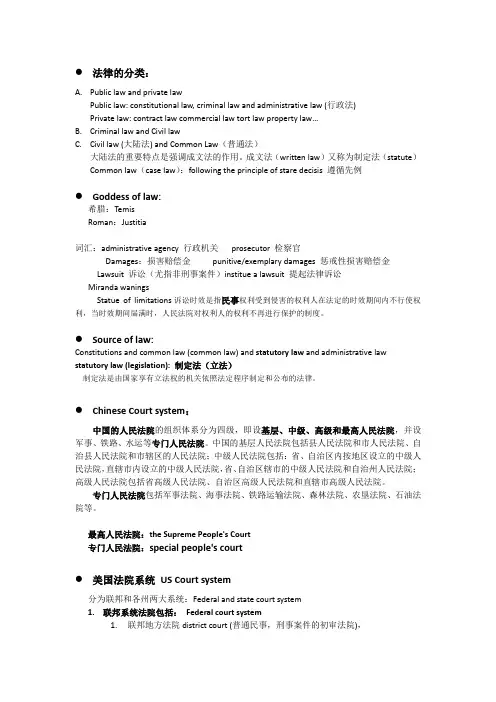
●法律的分类:A.Public law and private lawPublic law: constitutional law, criminal law and administrative law (行政法)Private law: contract law commercial law tort law property law…B.Criminal law and Civil lawC.Civil law (大陆法) and Common Law(普通法)大陆法的重要特点是强调成文法的作用。
成文法(written law)又称为制定法(statute)Common law(case law):following the principle of stare decisis 遵循先例●Goddess of law:希腊:TemisRoman:Justitia词汇:administrative agency 行政机关prosecutor 检察官Damages:损害赔偿金punitive/exemplary damages 惩戒性损害赔偿金Lawsuit 诉讼(尤指非刑事案件)institue a lawsuit 提起法律诉讼Miranda waningsStatue of limitations诉讼时效是指民事权利受到侵害的权利人在法定的时效期间内不行使权利,当时效期间届满时,人民法院对权利人的权利不再进行保护的制度。
●Source of law:Constitutions and common law (common law) and statutory law and administrative law statutory law (legislation): 制定法(立法)制定法是由国家享有立法权的机关依照法定程序制定和公布的法律。
●Chinese Court system:中国的人民法院的组织体系分为四级,即设基层、中级、高级和最高人民法院,并设军事、铁路、水运等专门人民法院。
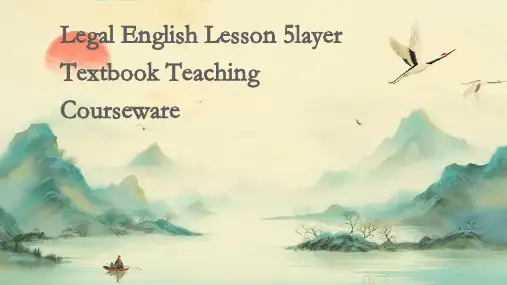
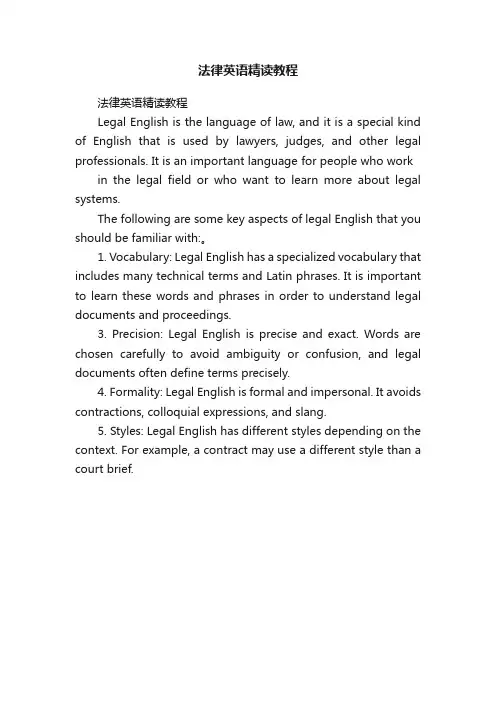
课时:2课时教学目标:1. 让学生掌握法律英语的基本概念和术语。
2. 培养学生阅读和理解法律英语文本的能力。
3. 提高学生的法律英语写作和翻译水平。
教学重点:1. 法律英语的基本概念和术语。
2. 法律英语文本的阅读和理解。
3. 法律英语写作和翻译技巧。
教学难点:1. 法律英语专业术语的理解和应用。
2. 法律英语文本的深入解读。
3. 法律英语写作和翻译的技巧。
教学过程:第一课时:一、导入1. 向学生介绍法律英语的基本概念和重要性。
2. 强调法律英语在法律实践中的重要性。
二、法律英语基本概念和术语1. 讲解法律英语的基本概念,如法律、法系、法律关系等。
2. 介绍常见的法律英语术语,如侵权、合同、诉讼等。
3. 让学生通过小组讨论,进一步理解和记忆这些术语。
三、法律英语文本阅读1. 分发法律英语文本,让学生阅读并总结文章的主要内容。
2. 引导学生关注法律英语文本的结构、语言特点和写作风格。
3. 针对文本中的难点,进行讲解和解析。
四、课堂练习1. 让学生完成课后练习,巩固所学知识。
2. 对学生的练习进行点评和指导。
第二课时:一、复习1. 复习上节课所学的法律英语基本概念和术语。
2. 检查学生对法律英语文本阅读的理解程度。
二、法律英语写作1. 讲解法律英语写作的基本要求和技巧。
2. 举例说明法律英语写作的常用句型和结构。
3. 让学生尝试撰写简单的法律英语文章。
三、法律英语翻译1. 讲解法律英语翻译的基本原则和技巧。
2. 举例说明法律英语翻译的难点和解决方案。
3. 让学生进行法律英语翻译练习。
四、课堂练习1. 让学生完成课后练习,提高法律英语写作和翻译能力。
2. 对学生的练习进行点评和指导。
五、总结1. 总结本节课所学的法律英语写作和翻译技巧。
2. 强调法律英语在实际应用中的重要性。
教学反思:本节课通过讲解、讨论、练习等多种形式,帮助学生掌握了法律英语的基本概念、术语、阅读技巧、写作和翻译技巧。
在教学过程中,要注意关注学生的个体差异,因材施教,提高教学效果。
Unit 11Criminal LawTextⅠCrime and PunishmentDictionary Workoffence, omission, prosecute, compensate, concurrently, plead, felony, incarceration, mala in se, mala prohibita, inherently, fornication, sodomy, heritage, espouse (v.), notwithstanding, perpetrator, justifiable, proclaim, adhere toPre-reading Questions1.What is a crime?2.How many classifications of the crime are there as far as you know?3.What is the relationship between criminal law and punishment?Definition1For many countries one of the most serious domestic problem is crime. What is a crime? How to give it a definition?It varies from country to country and from time to time. A crime or offence is an illegal act, omission or event, whether or not it is also a tort, a breach of contract or a breach of trust, the principal consequence of which is that the offender, if he is detected and it is decided to prosecute, is prosecuted by or in the name of the State, and if he is found guilty is liable to be punished whether or not he is also ordered to compensate his victim.2 A wrong is a breach of a rule; it may be moral or legal according to whether the rule is one of morality or law. Legal wrongs may be civil or criminal, and this distinction depends upon that between civil and criminal law. The civil law is primarily concerned with the rights and duties of individuals among themselves, whereas the criminal law defines the duties which a person owes to society, but a legal wrong may be both civil and criminal.3Sometimes, the same conduct may be both a civil wrong and a crime. There are many cases in which one who commits a tort is also guilty of a crime. Assaults and collisions between vehicles are two out of numerous examples. Where a crime is also a civil wrong, criminal and civil proceedings may usually take place concurrently and the one is normally no bar to the other.4The only exception to this rule of any general importance is that, where criminal proceedings are taken in a magistrates’ court in respect of a common assault or battery by or on behalf of the party aggrieved, the defendant is released from all other proceedings, civil or criminal, for the same cause, if he obtains the magistrates’ certificate of the dismissal of the complaint or undergoes the punishment inflicted upon him. A certificate of dismissal must be issued if the magistrates decide that the offence is not proved, or if proved is so trifling as not to merit any punishment. Thepower to dismiss a case even though the offence is proved, which is peculiar to the above off ences, depends on there having been a hearing “on the merits” and this will not have occurred if the accused pleaded guilty.Criminal Law Classifications5Criminal law classifies crimes according to various criteria, including (1) the nature and degree of p enalty attached, (2) the nature and degree of “evil” involved, and (3) the kind of social harm.Felony, Misdemeanor, and Violation6 The past influences present criminal law. The great legal historian Frederic William Maitland maintained that the reasons for old classifications may have long since died, but their ghost ruel us from the grave. He meant that even when classifications have outlived their usefulness, they influence present practice. The classification that divides crimes into felonies and misdemeanors represents one example of the past ruling us from the grave. Historically, felonies were crimes punishable by death. Present law divides felonies into capital felonies and ordinary felonies. Therefore, the category includes both serial killers such as Ted Bundy at one extreme and individuals who steal £500 at the other. The breadth of its scope makes the classification largely meaningless in any sociological sense. It serves mainly as an administrative device to determine who gets the death penalty, life imprisonment, or incarceration in a state prison.7 Misdemeanors include crimes punishable either by fines or up to one year in jail. Common misdemeanors include simple assaults and battery, prostitution, and disorderly conduct. Most jurisdictions divide misdemeanors into gross misdemeanors.A third category of crime is violation. Traffic offenses fall into this group..Mala in se and Mala Prohibita8Another legal classification sorts crimes according to their perceived “evil.” This old arrangement overlaps the felony, misdemeanor, and violation categories and defines some crimes as inherently bad (the Latin mala in se). Crimes such as murder and rape fall into this category. Other behavior constitutes a crime only because the law says so (the Latin mala prohibita). Parking in a “no parking” zone is malum prohibitum.9This classification reflects American criminal law’s roots in the religious and moral codes of England and colonial America. Although frequently viewed as a preoccupation of the New England Puritans, the Anglicans of Virginia, Pennsylvania Quakers, and Maryland Catholics also infused criminal law with a moral component. The major felonies and “morals” offenses, fornication, prostitution, sodomy, gambling, and public drunkenness, descend from this religious and moral heritage.10In practice, no bright line separates mala in se and mala prohibita offenses. In fact, research demonstrates that despite legal theories espousing the distinction, and notwithstanding talk of an ethical core in the criminal law, perpetrators consider manycrimes formally classified mala in se “justifiable”-that is, a means to put right a keenly felt wrong. They believe their conduct may have been “technically” a crime, but definitely not evil. Despite these findings, legal theorists cling to the distinction.Crime, Law and Punishment11 “N o crime without law and no punishment without law” proclaim two ancient maxims governing formal criminal justice. Formally, modern criminal law adheres to these maxims in the firmly fixed principle of legality that underlies the substantive criminal law, that is, the law that defines what constitutes a crime. The principle of legality also applies to the law of criminal procedure, the law that prescribes how the government enforces the substantive criminal law, in such constitutional commands as “no deprivation of life, liberty, or property without due process of law” and the guarantee of equal protection of the laws.12In practice, much reprehensible conduct, some of which causes considerable harm, occurs in every society. Neither all of that conduct nor all of that harm constitutes a crime. The law determines the distinction between unethical, immoral injury that justifies non-criminal legal action and criminal conduct and harm. To qualify as crimes, conduct or harm must satisfy five requirements; (1) A specific law prohibits the conduct and/or harm. (2) The law prescribes a penalty for the prohibited conduct and/or harm. (3) The particular law conforms to the general purposes and principles of criminal law. (4) The government must adhere to the rules of procedure in administering and enforcing the criminal law. (5) The punishment prescribed and actually administered accords with the Constitution’s prohibition against cruel an d unusual punishment.(1089words) Cross Jones &Card, Introduction to Criminal Law, 11th edition, Butterworth & Co (Publishers) Ltd.; Joel Samaha, Criminal Justice, 2nd edition, West Publishing CompanyNotes_________________________1.capital felony: Crime punishable by death or life imprisonment.可判死刑或终生监禁的重罪。
Unit One Legal SystemListeningI. c a d a bII. statutes, constitutions, cite, interpreted, civil, cases, liability, created, modified, repealedText A.Building up your vocabularyI. Match the items in the following two columnsA-civil law b-code c-validity d-jurisdiction e-clusterf-decree g-codification h-statute i-parliament j-legislatureII. Fill in the blanks:1. subdivision2. maxim3. federal4. enforcement5. statutes6. precedent7. Legislation8.Stare decisis9. legal ,legal 10. judicial , judicialClozeDocuments lawsuit trial attorneys advisors,Clients juries alternative practice representationTranslation1. 根据美国宪法,联邦政府分为行政、立法和司法三大部门,每个部门都被认为是独立的,并且能够相互制衡。
2. 通常有三类案件可以到达最高法院,即:牵涉到诉讼当事人分属不同的州的案件,牵涉到解释联邦法案的案件和解释美国宪法的案件。
3. 大律师事务所的律师平均收入最高;他们常常代理那些最有钱且最有社会地位的当事人;而且同高层次的法官和政府官员有着密切的联系。
个人执业者和小律师事务所的律师收入最低,代理那些既没钱又没社会地位的当事人,而且主要同最低级别的法院和行政机构打交道。